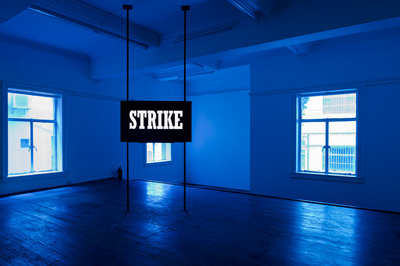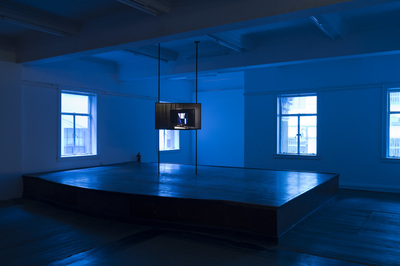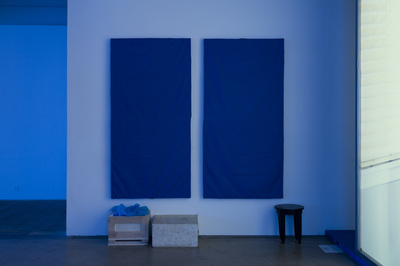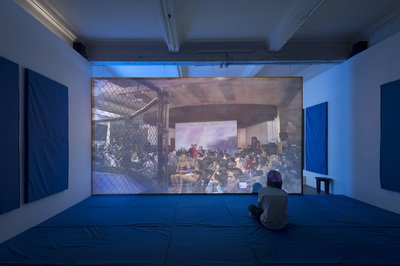The BANK Show, Hito Steyerl
Duration: 2015.07.18-2015.08.30
Hito Steyerl (b. 1966 ) Berlin-based artist , one of the most critically acclaimed artists working in the field of video today. She completed her film studies in Munich and Tokyo, and earned her PhD at the Academy of Fine Arts in Vienna. Steyerl’s work focuses on contemporary issues such as feminism and militarisation, as well as the mass proliferation and dissemination of images and knowledge brought on by digital technologies. She has participated in a number of leading exhibitions, such as Documenta, Manifesta, as well as biennials in Venice, Taipei, Istanbul and Gwangju.
About Curation
“My conviction is that, now more than ever, real life is much stranger than any fiction one could imagine. So somehow the forms of reporting have to become crazier and stranger, too. Otherwise they are not going to be ‘documentary’ enough; they are not going to live up to what’s happening.”
–Hito Steyerl in conversation with Laura Poitras, in the May 2015 issues of Artforum.
We live in odd times. And this oddity is made exponentially more perceivable and accessible by the barrage of new techniques available to observe our reality. The rhetoric used to be that oversaturation numbs, but late capitalism has evolved with such velocity and intensity that original sensibilities have not only emerged but erupted within this space, often to the willing negligence of the novelty-obsessed art world. When visual art is submitted to “viral spreading” and “language to the fake regime of advertising” (Franco Berardi), and as wechat-commerce lingo translates into real profit and solidifies into style, our ways of critical thinking and cultural production will just have to evolve along.
If the inaugural “THE BANK SHOW: Vive le Capital” marked an effort to come to terms with the fact that contemporary art is—and can only be, for a while—embedded and operative in a world calibrated by global capital, its sequel focuses on a single artist whose singular approach to navigating the unstable grounds of contemporary life “in the neoliberal thick of things” feels more relevant than ever, perhaps eerily so. When Liquidity Inc., the main attraction in this exhibition, first came out in 2014, the fate of its protagonist Jacob Wood—an adopted Vietnam War orphan turned Lehman Brothers financier turned MMA (mixed martial arts) fighter after losing his job in the 2008 economic crisis—already felt like an all too familiar narrative with the last global financial fiasco securely tucked into the past. Yet now as you sit on the Hokusai-inspired ramp specially constructed to experience this video, 1.93 million Euros had just been raised on a crowd-funding platform that ultimately failed to resuscitate the Greek economy and, together with China’s stock market downfall, one can only forecast continued instability for the global economy and the world that it sustains.
Even though Liquidity Inc.’s main arc revolves around two of the most volatile global forces—the financial market and the climate—and how they shape the circumstances of individual lives, it also uninhibitedly explores the expanded connections among abstract ideas, historical events (Jacob’s Vietnam War origins and the radical, anti-war group The Weather Underground), and geopolitical dynamics with the nimbleness and comic relief that are the hallmarks of our post-internet, heavily imaged culture. The essence of liquidity is to adapt. As Bruce Lee preaches at the beginning of the video :“Be like water, my friend” whether in fighting, in portfolio management, or, it would seem, in making sense of contemporary reality. As many art practitioners tread cautiously by burdening still objects with too many references or interrogating a limited scope of topics with serious, established methodology, Hito Steyerl has reveled in and improvised on the erratically morphing language of hyper-reality.
In conjunction with the two works on view--Liquidity Inc. and STRIKE, a 2010 work that harks back to Sergei Eisenstein’s 1925 feature about a workers’ strike at the eve of the Bolshevik Revolution with piercing concision and potent whimsy, an integral component to THE BANK SHOW sequel is a small selection of the artist’s own theoretical (but wildly entertaining) texts which have been translated into Chinese for the first time through a collaboration with The Hunting (GU Qianfan, ZHANG Hanlu, and LIU Qianxi) and artforum.cn. This edition includes Steyerl’s seminal essays In Defense of the Poor Image (2009), Politics of Art: Contemporary Art and the Transition to Post-Democracy (2010), The Spam of the Earth: Withdrawal from Representation (2012), as well as a very recent conversation with Laura Poitras, journalist and director of the Academy Award-winning documentary Citizenfour. In this mind-bending exchange, Steyerl observes that Poitras’ film, which captured Edward Snowden amid his exposé of the NSA spying scandal as it unfolded, seems to “lie in the way all of you came together and then created the event, the story, and many of the tools to tell it while all hell was breaking loose around you.” Yet this “lie” seems to be the only way that we can navigate reality today, by creating and post-editing its narrative in real time.
How do we critically engage with events and circumstances of certain magnitude without the necessary historical distance? Hito Steyerl’s writings have already opened up some possibilities for fellow artists and art writers. While she predicted that alien intelligence will most likely understand our civilization through spam, due to its crushing dominance over our more refined attributes, her projections are firmly grounded in andtelling of our immediate reality, where “the dream team of hyper-capitalism” consists of men and women “on knock off antidepressants, fitted with enhanced body parts.” Too often the art world finds itself in desperate need of utopia, after life, or alternative futures (preferably free of the plight of capitalism), like some kind of ideological cleanse-juice, without realizing its impotence in producing interesting enough works about the present day. “How can people get away with being so boring?” Steyerl asks, reminding us that even in a world where our actions are only meaningful when imaged and our presence visible by coerced participation in capitalism, there remains vast, uncharted territories that hold promises for a new discourse in art and politics.
Text / Xin Wang
展期: 2015.07.18-2015.08.30
黑特·史德耶尔,1966年出生于德国,是当今视频艺术领域最受赞誉的柏林艺术家。她在慕尼黑和东京学习电影研究,并取得维也纳艺术学院博士学位。史徳耶尔的作品关注一系列当代社会议题,涉及女权主义、军事化以及由电子技术带来的图像和知识的大规模生产和传播。她参与了一系列重要的当代艺术展览,包括Documenta(卡塞尔文献展)、Manifesta、威尼斯双年展、台北双年展、伊斯坦布尔双年展和光州双年展等。
关于策展
“我深信,与以往任何时候相比,现实生活都比人们所能想象的虚构故事要离奇得多。因此报道的形式就不得不也变得更疯狂、更离奇。否则就会不够‘纪实’,就会辜负所发生的事件。”
--黑特·史德耶尔与罗拉·柏翠丝的访谈,摘自《艺术论坛》2015年5月刊。
我们生活在荒诞的时代。而且这种荒诞怪异随着观察技术的更新繁荣变得愈发触手可及。曾经流行的看法是信息过度饱和令人昏聩麻木,然而晚期资本主义不断演变地更高更强,导致一些颇为独特的感性经验开始萌芽,继而爆发,但这些新兴能量却依然被执迷新事物的艺术界刻意忽视。在这个视觉艺术屈服于“热门转发”、语言为“广告业的虚假制度”服务(弗兰科·贝拉尔迪)、微信买卖文体转化为实际利润并形成独特风格的时代,我们批判性思维的方式和文化生产的手段实在不得不与时俱进。
如果说首期THE BANK SHOW: Vive le Capital(银行展:资本万岁)基于对这样一种现实的接受, 即当代艺术目前只能在全球资本衡量之下的世界中扎根运作,那么此次“续集”则聚焦一位以独特的方式驾驭当代生活崎岖地貌的艺术家。而她的实践创作往往与现实太过相关。在本次展览核心装置《Liquidity Inc.(流动(资本)公司)》2014年完成之初,其主人公雅克布·伍德的命运已令人感到莫名熟悉:越战中成为遗孤被收养,后进入雷曼兄弟从事金融工作,在2008年的金融危机中丢了工作后又以参加综合格斗谋生;上一次全球经济危机似乎已被尘封于历史之中。然而当你坐在特意为影像作品搭建的、以北斋巨浪为灵感设计的坡道上时, 紧急融资复苏希腊的号召刚在众筹平台上募集了一百九十三万欧元资金(此举以未达到设定目标金额而失败),而中国股市的暴跌则为全球金融的未来预期平添不安。
《流动(资本)公司》的主线围绕着当今全球最反复无常的两大力量--金融市场和气候--展开,描摹在其淫威之下的个人境遇,同时也毫无顾忌地探讨抽象概念、历史事件(雅克布生于越南战争期间的身世背景和片中提及的70年代反战激进组织“地下气象员”)以及地缘动态之间在更广范围中的关联。她的实践方式变通、机巧、幽默,正是后网络重度图像化当代文化的鲜明特征。诚如李小龙在视频开头所劝诫的那样(“如水而行吧,我的朋友”),流动性的精髓便是学会变通,不论是搏斗、证券管理,还是在揣摩当代种种现实意义的时候。当众多艺术实践者依旧谨言慎行,让静止的艺术物件背负太多引申含义,或以太过严谨考究的方法处理有明确范围限定的话题时,黑特·史德耶尔已经在这种分秒流变的文化语言中游刃有余、纵情逸乐。
也因此,除了展出两件与“银行展”概念契合的作品--《流动(资本)公司》和《STRIKE》 (致敬对象是Sergei Eisenstein 1925年关于俄国革命前夕工人罢工事件的同名电影),本次THE BANK SHOW续集的一个重要组成部分是艺术家的写作: 从出版过的论文与访谈中被甄选一小部分,通过与“狩猎”(顾虔凡, 张涵露, 刘倩兮) 以及《艺术论坛》中文网的合作,首次译成中文出版。此系列包括艺术家影响深远的论文--《为坏图像辩护》(In Defense of the Poor Image, 2009), 《艺术的政治:当代艺术及其后民主转向》(Politics of Art: Contemporary Art and the Transition to Post-Democracy, 2010), 《地球的垃圾邮件:从再现中抽身》(The Spam of the Earth: Withdrawal from Representation, 2012), 以及她与独立记者、奥斯卡获奖纪录片《第四公民》导演罗拉·柏翠丝最新的访谈录。在这段发人深省的对话中,史德耶尔注意到,柏翠丝的这部追踪爱德华·斯诺登揭露NSA (美国国家安全局) 监视丑闻事件发酵而摄的影片似乎“在某种意义上存在着编造/欺骗:所有参与者聚在一起创造了这个事件、这个故事,还创作了多种叙事工具与手段;与此同时又被巨变挟裹其中。” 然而这种“编造”又似乎是我们驾驭当下现实的唯一途径--即时编造叙事并对其进行后期编辑。
言至于此,我们到底如何在缺乏必要的历史距离的情况下,批判性地应对有一定深远影响的事件和境况?史德耶尔的写作方式已经为艺术家以及艺术写作者同行们开辟了许多脑洞。此外,虽然她令人信服地预测了外星人在未来极有可能只会通过垃圾图文(spam)理解人类文明--鉴于spam完全以压倒性优势遮蔽了我们更为文雅的成就,她的种种预测依旧稳实地扎根于眼前无法逃避的现实。在这个现实中,“嗑着廉价抗抑郁药,带着改良身体器官”的各色男女组成“超资本主义的梦之队”。艺术界时常陷入对某个乌托邦、来世、或另一种未来(最好能让我们逃脱资本主义的魔掌)的深深渴求,仿佛它们是某种能为意识形态排毒的鲜榨果汁, 却不曾意识到我们甚至生产不出多少达标的、有趣的针对当今局势的创作实践。 “他们怎么能那么无聊?” 史德耶尔的质疑提醒了我们,即使当下我们只能在图像中行动,即使我们只有在被迫参与资本主义体系之中才称得上“存在“,这样的世界里依然有着辽阔未知的领域,而那里承载着发现新的艺术以及政治话语的希望。
文/王辛
Duration: 2015.07.18-2015.08.30
Hito Steyerl (b. 1966 ) Berlin-based artist , one of the most critically acclaimed artists working in the field of video today. She completed her film studies in Munich and Tokyo, and earned her PhD at the Academy of Fine Arts in Vienna. Steyerl’s work focuses on contemporary issues such as feminism and militarisation, as well as the mass proliferation and dissemination of images and knowledge brought on by digital technologies. She has participated in a number of leading exhibitions, such as Documenta, Manifesta, as well as biennials in Venice, Taipei, Istanbul and Gwangju.
About Curation
“My conviction is that, now more than ever, real life is much stranger than any fiction one could imagine. So somehow the forms of reporting have to become crazier and stranger, too. Otherwise they are not going to be ‘documentary’ enough; they are not going to live up to what’s happening.”
–Hito Steyerl in conversation with Laura Poitras, in the May 2015 issues of Artforum.
We live in odd times. And this oddity is made exponentially more perceivable and accessible by the barrage of new techniques available to observe our reality. The rhetoric used to be that oversaturation numbs, but late capitalism has evolved with such velocity and intensity that original sensibilities have not only emerged but erupted within this space, often to the willing negligence of the novelty-obsessed art world. When visual art is submitted to “viral spreading” and “language to the fake regime of advertising” (Franco Berardi), and as wechat-commerce lingo translates into real profit and solidifies into style, our ways of critical thinking and cultural production will just have to evolve along.
If the inaugural “THE BANK SHOW: Vive le Capital” marked an effort to come to terms with the fact that contemporary art is—and can only be, for a while—embedded and operative in a world calibrated by global capital, its sequel focuses on a single artist whose singular approach to navigating the unstable grounds of contemporary life “in the neoliberal thick of things” feels more relevant than ever, perhaps eerily so. When Liquidity Inc., the main attraction in this exhibition, first came out in 2014, the fate of its protagonist Jacob Wood—an adopted Vietnam War orphan turned Lehman Brothers financier turned MMA (mixed martial arts) fighter after losing his job in the 2008 economic crisis—already felt like an all too familiar narrative with the last global financial fiasco securely tucked into the past. Yet now as you sit on the Hokusai-inspired ramp specially constructed to experience this video, 1.93 million Euros had just been raised on a crowd-funding platform that ultimately failed to resuscitate the Greek economy and, together with China’s stock market downfall, one can only forecast continued instability for the global economy and the world that it sustains.
Even though Liquidity Inc.’s main arc revolves around two of the most volatile global forces—the financial market and the climate—and how they shape the circumstances of individual lives, it also uninhibitedly explores the expanded connections among abstract ideas, historical events (Jacob’s Vietnam War origins and the radical, anti-war group The Weather Underground), and geopolitical dynamics with the nimbleness and comic relief that are the hallmarks of our post-internet, heavily imaged culture. The essence of liquidity is to adapt. As Bruce Lee preaches at the beginning of the video :“Be like water, my friend” whether in fighting, in portfolio management, or, it would seem, in making sense of contemporary reality. As many art practitioners tread cautiously by burdening still objects with too many references or interrogating a limited scope of topics with serious, established methodology, Hito Steyerl has reveled in and improvised on the erratically morphing language of hyper-reality.
In conjunction with the two works on view--Liquidity Inc. and STRIKE, a 2010 work that harks back to Sergei Eisenstein’s 1925 feature about a workers’ strike at the eve of the Bolshevik Revolution with piercing concision and potent whimsy, an integral component to THE BANK SHOW sequel is a small selection of the artist’s own theoretical (but wildly entertaining) texts which have been translated into Chinese for the first time through a collaboration with The Hunting (GU Qianfan, ZHANG Hanlu, and LIU Qianxi) and artforum.cn. This edition includes Steyerl’s seminal essays In Defense of the Poor Image (2009), Politics of Art: Contemporary Art and the Transition to Post-Democracy (2010), The Spam of the Earth: Withdrawal from Representation (2012), as well as a very recent conversation with Laura Poitras, journalist and director of the Academy Award-winning documentary Citizenfour. In this mind-bending exchange, Steyerl observes that Poitras’ film, which captured Edward Snowden amid his exposé of the NSA spying scandal as it unfolded, seems to “lie in the way all of you came together and then created the event, the story, and many of the tools to tell it while all hell was breaking loose around you.” Yet this “lie” seems to be the only way that we can navigate reality today, by creating and post-editing its narrative in real time.
How do we critically engage with events and circumstances of certain magnitude without the necessary historical distance? Hito Steyerl’s writings have already opened up some possibilities for fellow artists and art writers. While she predicted that alien intelligence will most likely understand our civilization through spam, due to its crushing dominance over our more refined attributes, her projections are firmly grounded in andtelling of our immediate reality, where “the dream team of hyper-capitalism” consists of men and women “on knock off antidepressants, fitted with enhanced body parts.” Too often the art world finds itself in desperate need of utopia, after life, or alternative futures (preferably free of the plight of capitalism), like some kind of ideological cleanse-juice, without realizing its impotence in producing interesting enough works about the present day. “How can people get away with being so boring?” Steyerl asks, reminding us that even in a world where our actions are only meaningful when imaged and our presence visible by coerced participation in capitalism, there remains vast, uncharted territories that hold promises for a new discourse in art and politics.
Text / Xin Wang
展期: 2015.07.18-2015.08.30
黑特·史德耶尔,1966年出生于德国,是当今视频艺术领域最受赞誉的柏林艺术家。她在慕尼黑和东京学习电影研究,并取得维也纳艺术学院博士学位。史徳耶尔的作品关注一系列当代社会议题,涉及女权主义、军事化以及由电子技术带来的图像和知识的大规模生产和传播。她参与了一系列重要的当代艺术展览,包括Documenta(卡塞尔文献展)、Manifesta、威尼斯双年展、台北双年展、伊斯坦布尔双年展和光州双年展等。
关于策展
“我深信,与以往任何时候相比,现实生活都比人们所能想象的虚构故事要离奇得多。因此报道的形式就不得不也变得更疯狂、更离奇。否则就会不够‘纪实’,就会辜负所发生的事件。”
--黑特·史德耶尔与罗拉·柏翠丝的访谈,摘自《艺术论坛》2015年5月刊。
我们生活在荒诞的时代。而且这种荒诞怪异随着观察技术的更新繁荣变得愈发触手可及。曾经流行的看法是信息过度饱和令人昏聩麻木,然而晚期资本主义不断演变地更高更强,导致一些颇为独特的感性经验开始萌芽,继而爆发,但这些新兴能量却依然被执迷新事物的艺术界刻意忽视。在这个视觉艺术屈服于“热门转发”、语言为“广告业的虚假制度”服务(弗兰科·贝拉尔迪)、微信买卖文体转化为实际利润并形成独特风格的时代,我们批判性思维的方式和文化生产的手段实在不得不与时俱进。
如果说首期THE BANK SHOW: Vive le Capital(银行展:资本万岁)基于对这样一种现实的接受, 即当代艺术目前只能在全球资本衡量之下的世界中扎根运作,那么此次“续集”则聚焦一位以独特的方式驾驭当代生活崎岖地貌的艺术家。而她的实践创作往往与现实太过相关。在本次展览核心装置《Liquidity Inc.(流动(资本)公司)》2014年完成之初,其主人公雅克布·伍德的命运已令人感到莫名熟悉:越战中成为遗孤被收养,后进入雷曼兄弟从事金融工作,在2008年的金融危机中丢了工作后又以参加综合格斗谋生;上一次全球经济危机似乎已被尘封于历史之中。然而当你坐在特意为影像作品搭建的、以北斋巨浪为灵感设计的坡道上时, 紧急融资复苏希腊的号召刚在众筹平台上募集了一百九十三万欧元资金(此举以未达到设定目标金额而失败),而中国股市的暴跌则为全球金融的未来预期平添不安。
《流动(资本)公司》的主线围绕着当今全球最反复无常的两大力量--金融市场和气候--展开,描摹在其淫威之下的个人境遇,同时也毫无顾忌地探讨抽象概念、历史事件(雅克布生于越南战争期间的身世背景和片中提及的70年代反战激进组织“地下气象员”)以及地缘动态之间在更广范围中的关联。她的实践方式变通、机巧、幽默,正是后网络重度图像化当代文化的鲜明特征。诚如李小龙在视频开头所劝诫的那样(“如水而行吧,我的朋友”),流动性的精髓便是学会变通,不论是搏斗、证券管理,还是在揣摩当代种种现实意义的时候。当众多艺术实践者依旧谨言慎行,让静止的艺术物件背负太多引申含义,或以太过严谨考究的方法处理有明确范围限定的话题时,黑特·史德耶尔已经在这种分秒流变的文化语言中游刃有余、纵情逸乐。
也因此,除了展出两件与“银行展”概念契合的作品--《流动(资本)公司》和《STRIKE》 (致敬对象是Sergei Eisenstein 1925年关于俄国革命前夕工人罢工事件的同名电影),本次THE BANK SHOW续集的一个重要组成部分是艺术家的写作: 从出版过的论文与访谈中被甄选一小部分,通过与“狩猎”(顾虔凡, 张涵露, 刘倩兮) 以及《艺术论坛》中文网的合作,首次译成中文出版。此系列包括艺术家影响深远的论文--《为坏图像辩护》(In Defense of the Poor Image, 2009), 《艺术的政治:当代艺术及其后民主转向》(Politics of Art: Contemporary Art and the Transition to Post-Democracy, 2010), 《地球的垃圾邮件:从再现中抽身》(The Spam of the Earth: Withdrawal from Representation, 2012), 以及她与独立记者、奥斯卡获奖纪录片《第四公民》导演罗拉·柏翠丝最新的访谈录。在这段发人深省的对话中,史德耶尔注意到,柏翠丝的这部追踪爱德华·斯诺登揭露NSA (美国国家安全局) 监视丑闻事件发酵而摄的影片似乎“在某种意义上存在着编造/欺骗:所有参与者聚在一起创造了这个事件、这个故事,还创作了多种叙事工具与手段;与此同时又被巨变挟裹其中。” 然而这种“编造”又似乎是我们驾驭当下现实的唯一途径--即时编造叙事并对其进行后期编辑。
言至于此,我们到底如何在缺乏必要的历史距离的情况下,批判性地应对有一定深远影响的事件和境况?史德耶尔的写作方式已经为艺术家以及艺术写作者同行们开辟了许多脑洞。此外,虽然她令人信服地预测了外星人在未来极有可能只会通过垃圾图文(spam)理解人类文明--鉴于spam完全以压倒性优势遮蔽了我们更为文雅的成就,她的种种预测依旧稳实地扎根于眼前无法逃避的现实。在这个现实中,“嗑着廉价抗抑郁药,带着改良身体器官”的各色男女组成“超资本主义的梦之队”。艺术界时常陷入对某个乌托邦、来世、或另一种未来(最好能让我们逃脱资本主义的魔掌)的深深渴求,仿佛它们是某种能为意识形态排毒的鲜榨果汁, 却不曾意识到我们甚至生产不出多少达标的、有趣的针对当今局势的创作实践。 “他们怎么能那么无聊?” 史德耶尔的质疑提醒了我们,即使当下我们只能在图像中行动,即使我们只有在被迫参与资本主义体系之中才称得上“存在“,这样的世界里依然有着辽阔未知的领域,而那里承载着发现新的艺术以及政治话语的希望。
文/王辛













